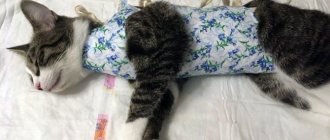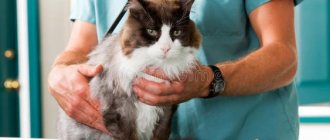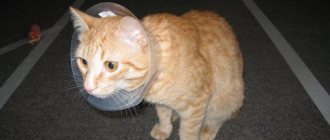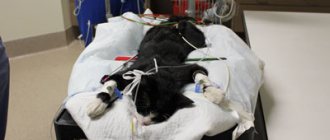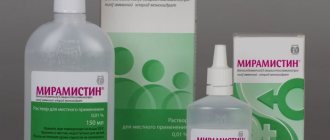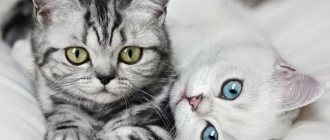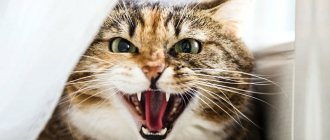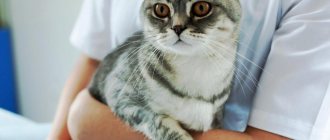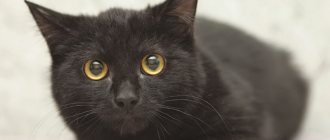The suture during sterilization of cats can be quite large when performing surgery along the white line of the abdomen, small (no more than 1 cm) when sterilizing using the lateral incision method, and practically invisible when sterilizing using laparoscopy. The veterinary specialist who performed the surgery will explain what the stitch should be after sterilizing the cat.
Depending on the chosen surgical technique, the size of the seam will differ. As a rule, sutures are placed when cutting the muscle layers and skin during sterilization along the white line of the abdomen.
This technique is widely used when removing the uterus and ovaries (ovariohysterectomy). When only the ovaries are removed, more gentle techniques are used that do not require a large number of stitches, or are absent altogether (with laparoscopy).
Internal sutures are placed on the muscle layers using self-absorbable suture material, and external sutures are sutured with surgical threads, which must later be removed.
Depending on what kind of suture the cat has after sterilization, the rate of tissue regeneration will depend. It is important to note that during the entire postoperative period the suture should remain clean and as dry as possible.
If any pathological changes are detected - suppuration, inflammatory processes or bloody discharge, you must contact a veterinary clinic in order to avoid serious complications.
General recommendations
Before taking your pet for sterilization, it is necessary to prepare conditions that will reduce the cat’s discomfort after surgery and provide adequate care.
How quickly a cat recovers after sterilization depends on proper postoperative care.
Blanket (bandage)
To protect the seam from damage, the animal is put on a special blanket.
The bandage is made of cotton fabric and has several useful functions:
- Does not allow you to lick the seam. A rough cat's tongue irritates the postoperative wound, impairing healing.
- Protects against dust, thereby reducing the risk of inflammation.
- Slightly reduces flexibility. The cat arches less when licking the crotch and hind legs, and this reduces the risk of seams coming apart.
Wearing a blanket is necessary during the entire period of healing of the postoperative wound. The bandage does not cause any discomfort to the cat.
Important! Some animals react negatively to wearing a blanket: they try to tear it off and move less. It is necessary to ensure that the cat cannot remove the bandage and lick the wound. And there is no need to worry about a decrease in activity: after the blanket is removed, the pet will become the same again.
Eyes
The surgery is performed under general anesthesia and the cat is returned to the owner in a state of anesthesia. Most anesthetized animals have their eyes open and not blinking.
To avoid drying out the cornea, veterinarians recommend:
- gently close your eyes, moving your eyelids with your fingers (pretend to blink);
- drip 0.9% sodium chloride or “Artificial tears”.
Humidification must be continued until the pet begins to blink on its own.
General condition of the house
Before you go for sterilization, you need to prepare a bed.
The place must meet the following requirements:
- Be on the floor. After awakening, coordination is impaired and the animal can be injured by falling from a height.
- Have a heating pad and soft bedding. During anesthesia, the thermoregulation process is disrupted and body temperature is reduced.
- Be covered with an absorbent diaper (available at a pharmacy). When recovering from anesthetized sleep, the cat may have involuntary bowel movements or emptying of the bladder. Some animals vomit.
If there is another pet at home, then it is necessary to limit its access to the room where the operated cat is located.
Coming out of anesthesia
After anesthesia, the pet should be placed on a heating pad on its right side - this position will reduce the load on the heart.
Before waking up, you need to moisten your eyes and observe the general condition
Before waking up, you need to moisten your eyes and observe the general condition. If vomiting occurs, turn your head to the side so that the animal does not choke on the vomit.
Be sure to read:
After sterilization, a cat sleeps a lot and is lethargic: normal or pathological, what consequences may occur after surgery
Coming out of anesthesia, the pet begins to move and tries to get up. The first steps will be poorly coordinated, the animal will stagger and bump into furniture. During this period, it is important to limit the cat's movements.
The animal may show signs of inappropriate behavior:
- unmotivated aggression (growling, hissing);
- attempts to crawl and hide;
- lack of reaction to the nickname.
The cause of inadequacy is pain and post-anesthesia disorientation. The cat is scared, trying to hide or defend itself.
It is necessary to ensure that the cat empties its intestines and bladder on the first day. Stagnation of urine and feces should not be allowed.
Important! From the moment of arrival from the clinic until the return of normal coordination and adequate behavior, the pet should not be left unattended. It is necessary to control movements and stop attempts to hide in hard-to-reach places.
Food and drink
On the first day, you don’t need to feed your pet, just give it water. First, feed from a syringe and make sure that the animal does not choke.
After complete recovery from anesthesia and restoration of swallowing movements, water is placed in a cup.
Feeding begins on day 2 and is given a third of the usual portion. Food should be low-fat and easy to digest. Increase the amount of food gradually.
Attention! In rare cases, it is possible to refuse food for 2-3 days. If a cat drinks water well and has no signs of deterioration in health, then this may be an individual characteristic of the body.
Processing and removal of seams
Before removing the suture, the postoperative wound should be treated daily with antiseptics that do not contain alcohol.
Before removing the suture, the postoperative wound should be cleaned daily.
It is better to carry out the treatment together: one person stands the animal upright and holds it by the front paws, and the second lifts the blanket and treats the wound, applying an antiseptic solution.
During processing, it is necessary to monitor the condition of the seam. It must be dry and clean.
Removal of suture stitches is carried out on days 7-10. You can contact a specialist or remove it yourself.
If the decision is made to remove at home, the nature of the procedure depends on the type of stitches:
- Staple. Looks like a thread tied in a knot. There are several such threads along the seam. It is necessary to pull the knot, separating it from the skin, cut the thread and pull it out.
- Continuous. The knots are located along the edges of the seam. You need to cut the knots, pull the thread in the middle and pull it out.
It is recommended to leave the blanket for another 1-2 days.
If the wound is overgrown with thick hair or the animal does not tend to lick the seam, you can remove the bandage after removing the suture threads.
Indications for removal of fixatives
- fracture healing after osteosynthesis;
- low quality metal product;
- limited mobility of the joint next to which the plate is located;
- damage to the fastener or displacement from the installation site;
- desire to remove a postoperative scar;
- playing sports with heavy physical exertion - the presence of an implant can lead to a re-fracture;
- installing a plate for a child or teenager - its presence will interfere with normal bone growth;
- the presence of osteoporosis – an implant on the lower limb increases the risk of recurrent fracture;
- infection of deep tissues;
- the patient’s tendency to allergic reactions to a certain type of alloy or metal;
- suppuration at the site of the surgical wound;
- removal - as one of the stages of treatment.
Medicines: analgesics, suture antiseptics, antibiotics, vitamins
In the first 2 days you will need to give analgesics . The fact that the postoperative wound hurts is indicated by a change in the animal’s behavior. The cat shows aggression, meows, and refuses to move.
Be sure to read:
After sterilization, the cat does not eat or drink for several days: what to do, what to feed
Analgesics will be required for the first 2 days.
Doctors recommend using painkillers:
- Ketoprofen (1% solution). The injection is given subcutaneously or intramuscularly once a day. The dose is calculated at 0.2 ml per kg of weight. Inject no more than 4 times.
- Tolfedine (tablets). Given with food. Dosage: 4 mg per kg.
- Meloxicam (suspension). On the first day, give 0.1 mg/kg, and in subsequent days, reduce the dose by half and give 0.05 mg/kg.
To treat sutures, veterinarians advise using:
- chlorhexidine 0.05%;
- Dioxidin 0.5%;
- Chemi spray;
- Vetericin spray.
During the recovery period after sterilization, antibacterial drugs are not prescribed. Antibiotics may be required if postoperative complications occur and an inflammatory process is detected.
For treatment use:
- Amoxicillin 15%. 1 ml/kg once a day for 5 days subcutaneously or intramuscularly.
- Sinulox. 0.5 ml/kg intramuscularly for 3-5 days.
Vitamins and restoratives are given only to old or weakened individuals. Gamavit is prescribed at 0.05 ml/kg for the first 3 days, and then the dose is increased to 0.1 mg/kg and given for 2 weeks.
Why do you have to remove metal structures after a fracture?
Complications often occur after such operations, as a result of which the fixators have to be removed earlier than planned.
Many factors influence the decision to remove metal structures: every year more and more manufacturers of fasteners appear and each uses new technologies, types of alloys and forms of fasteners. In addition, when applying for surgery to treat a fracture in one clinic, the patient may go to another to have the metal structure removed. Therefore, it is quite difficult for many doctors to decide whether to remove implants.
Care plan: first week day by day
After sterilization, doctors give a list of recommendations for caring for your pet.
Requirements depend on the time that has passed since the operation:
- 1st day. The cat comes out of anesthetized sleep for several hours. During this period, she is in an inadequate state: she tries to crawl away, shows aggression, and meows. It is necessary to limit the movement of your pet until coordination is restored. To eliminate pain, give an injection prescribed by a veterinarian. No feeding, only water.
- 2nd day. The animal is in pain and shows aggression or tries to hide. At this time, the pet makes its first attempts to lick the seam. You need to give painkillers or give an injection. You can start feeding in small portions.
- 3rd day. The condition is improving and there is almost no pain. The animal becomes active, asks for food, goes to the litter box. You should measure the temperature and if it increases or decreases, consult your veterinarian.
- 4th day. The pet eats and goes to the tray on its own. Despite the appearance of an appetite, it is impossible to overfeed a cat - after sterilization, animals tend to become obese.
- 5th day. The stitch is showing signs of scarring and is not painful. The cat can be allowed to walk around the apartment and jump on low surfaces.
- 6th day. No pain. The animal is active, eats well and goes to the tray.
- 7th day. The stitches are removed.
If the rehabilitation plan is followed, the pet will quickly recover after sterilization.
How long does it take for internal sutures to dissolve?
Modern veterinary clinics use special suture material to create internal scars, which can dissolve on its own. That is, in theory, removing the threads located under the skin is not required. But in practice, their resorption does not always occur. If a cat undergoes a second operation after a few years, specialists sometimes find encapsulated old suture material. It does not cause any trouble or inconvenience to the animal, so there is no need to remove it.
Possible postoperative complications
If the animal is healthy, then there are almost no complications.
But the owner needs to closely monitor the pet during rehabilitation in order to notice dangerous signs in time:
- Prolonged post-anesthesia hypothermia. After emerging from anesthesia, the animal lies motionless, and the tips of the ears and paws are cold. You need to measure your temperature rectally (the thermometer is inserted into the anus). If the thermometer shows less than 37°C, then place the cat on a heating pad on its right side and call a veterinarian.
- Prolonged hyperthermia. An alarming symptom when a temperature of 39° C lasts 3 days or more. The animal must be shown to a doctor.
- Bleeding. If the suture is leaking or blood is leaking from the vulva, the cat must be urgently taken to the clinic for a second operation.
- Suppuration of a postoperative wound. Complications occur due to improper care. Need specialist advice.
Be sure to read:
How long does it take for a cat to recover from anesthesia after castration: the condition immediately after surgery, which should alert you
Sometimes cats have difficulty passing stool after anesthesia and difficulty urinating.
Important! The owner needs to monitor the general condition of the pet, control visits to the litter box and monitor the healing of the suture. At the first signs of abnormalities, the cat should be taken to the veterinarian.
How to remove stitches after sterilization (cat)
Sterilization involves removing sutures after surgery on a cat, unless it is laparoscopy. Sutures are usually placed using two methods - internal and external. The internal connects the cut tissues inside (muscles, subcutaneous fat, etc.), and the vessels are also ligated. It is performed with special self-absorbing threads that do not require removal. An experienced veterinarian pays the greatest attention to the quality of internal sutures, since the condition of the animal after surgery directly depends on this. External sutures are usually performed with surgical sutures, in which case it will be necessary to remove the sutures after a certain time. In addition to removing stitches immediately after surgery, the cat will also need rehabilitation.
Do's, Don'ts and Don'ts
The owner needs to monitor the general condition of his pet.
The owner of a cat is often lost and does not always understand what is allowed and what is prohibited.
Can
The animal is not sick, but a minor operation, only a temporary deterioration in health.
Can:
- take your pet in your arms (do not put pressure on the stomach, picking it up under the hind and front paws);
- take him for short walks;
- give water without restrictions;
- provide food for sterilized cats.
Attention and moderate activity speed up rehabilitation.
Need to
To prevent possible complications it is necessary:
- keep the blanket clean;
- treat the postoperative wound daily;
- control the amount of food eaten (sterilized animals are prone to obesity).
It is necessary to take care of the eyes and ears, treat the fur from parasites, and remove tangles.
It is forbidden
Until the sutures are completely healed, it is prohibited:
- pick up the pet, picking it up under the belly;
- allow the animal to sleep on the radiator;
- allow active movement (first week);
- remove the bandage until the postoperative wound heals;
- leave a lot of food (portions should be measured).
Step-by-step instructions for removing sutures
Here are step-by-step instructions that must be strictly followed when removing suture material:
- Before starting work, you need to wait about ten minutes so that the soapy water, which we already talked about above, has time to soften the suture material.
- After this, you must definitely count how many stitches were placed. If possible, you should also call the veterinarian who performed the spay and ask how many stitches he used. This is necessary so as not to accidentally leave a couple of stitches. This, by the way, does not happen so rarely.
- You can start withdrawing. First, you need to thoroughly wipe the tweezers with alcohol, and then carefully grab the seam loop. It should be pulled upward as much as possible.
- As soon as the seam has stretched sufficiently, you need to insert the lower jaw of the scissors under it and cut the thread.
- To remove the remainder of the latter, you need to pull it out of the skin. This is done carefully and without unnecessary haste. If the thread is “stuck” to the skin, it is necessary to carefully turn it around its axis and pull the rest of the seam towards you. If you pull too hard, you can injure your cat, tearing the thin layer of newly healed skin.
If the seam does not give way, and a piece of thread comes out of the skin with great difficulty, there is no need to rush and tear it out “forcibly”. You can wipe the grout line again with warm soapy water and wait about an hour. After this period, the skin will soften, after which everything can be done without much effort.
Safety rules when removing sutures
In order not to endanger the life and health of the cat, the owner who decides to remove the stitches himself must strictly follow the safety rules below:
- It is not recommended to remove stitches unless they have been examined by a veterinarian first . Only an experienced specialist will be able to tell how well the postoperative wound has healed and how safe it will be to remove the suture material.
- It is forbidden to remove sutures if the suture line is “inflated” , inflamed, numerous areas of redness are observed, and the local temperature in these places is significantly increased. These signs indicate a strong inflammatory response. In such cases, you should call your veterinarian immediately.
- In cases where there is bleeding (even a drop), or the release of exudate (regardless of the volume of the latter), the sutures are also prohibited from being removed.
Remember! Even if none of the above is observed, but the cat is behaving strangely and nervously, it is better to have it examined by a veterinarian first.
